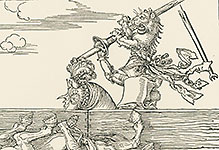
Prints
Etchings, Woodcuts,...

#33010955
'The Printer's Workshop', 1568. In the background two men are selecting letters...

#33010956
'An Allegory of a Prosperous Germany', 1586. Seated in the centre is Pallas Athe...
!['Allegory on the Equality of all Mankind in Death', 1599. The complex meaning of this image is derived from the Latin inscriptions. The most important is that at the top of the tent: "MORS CERTA RELIGONIBUS AEQVAT" (Death makes the sceptre and spade equal). Death is therefore the equaliser of people of all classes, from the peasant on the left to the Emperor on the right. The skeletons show no social distinction. On the rim of the tent stand an owl and a lamp, symbols of death and life respectively. The round scenes show the Fall of Man and the Crucifixion, representing the introduction and the conquering of death. The Last Judgement painted in the centre reminds the viewer of Divine Judgement. The boy blowing bubbles is a traditional emblem of transience dictated by the words inscribed over his head: "HOMO BULLA" (Man is [as] a soap bubble). The drawing and print of this theme of mortality and the passing of human existence are therefore designed to encourage the renunciation of all worldly pleasures and to prepare the viewer for death. De Gheyn sympathized with Protestant or Calvinist teachings as this drawing fully illustrates.
PD, 1895-9-15-1031](https://archive.lessingimages.com/photo/34343/thumb)
#33010957
'Allegory on the Equality of all Mankind in Death', 1599. The complex meaning of...

#33010962
'Albion Rose', c1796. Also known as 'Glad Day' or 'The Dance of Albion', in whic...

#33010963
'A Horse Affrighted by a Lion', 1777. The picture is intended to express the ter...

#33010966
"Linda maestra" - "Gentle mistress",etching No.68 from the "Caprichos",aro...

#33010967
"Alla va eso",("This way"),etching No.66 from the "Caprichos",around 1798.

#33010968
"O the Roast Beef of England", 1749. An overweight monk and a cook carrying a hu...

#33010969
Hogarth painting the muse of comedy, 1764. A self-portrait of him seated before...

#330111 2
'Picture Puzzle of Jonah and the Whale and a Squatting Peasant', 1537. The anamo...

#330111 3
'The Three Trees', 1643. The three trees are buffeted by gusts of wind and rise...

#330111 9
Title page of "Les Fantaisies , 1635. 14 etchings (one missing in the collectio...